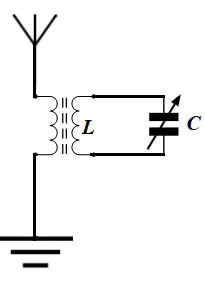Antenna and LC Circuit
This lecture is about radio signals and receiving of these signals by a device we call "radio".
We will not talk in this lecture about how to produce and transmit radio signals, only about receiving them.
In this and subsequent lectures we will use the concept of forced oscillation presented in lectures "Forced Oscillation 1", "Forced Oscillation 2" and "Problems 4" of the "Mechanical Oscillations" topic of the "Waves" part of this course.
We strongly recommend to familiarize yourselves with the material presented there prior to study the material of this lecture.
The space around us is filled with radio signals, which are, in essence, oscillations of electromagnetic field.
We don't see them because our eyes are sensitive to certain range of frequencies of oscillations of electromagnetic field called visible spectrum.
Radio frequencies used to carry information to our radio, television, wireless phones and other devices are outside of this visible spectrum and, therefore, are invisible, but they do exist and we live in space filled with oscillations of electromagnetic field.
These oscillations are not synchronous because they are produced by many unrelated to each other sources, including our Sun, planet Earth, numerous sources of electromagnetic field around our own devices, including transmitters that intentionally produce oscillating electromagnetic fields and those produced unintentionally because any electric device is a source of electromagnetic field around it.
So, the space around us is filled with chaotic waves of electromagnetic field, and our purpose is to "catch" specific waves that have specific frequency of oscillations, used to transmit specific information.
The circuit that contains an inductor and a capacitor can help, and here is how.
Any oscillations of electromagnetic field will cause the oscillations of electric current in a conductor (like a piece of wire) in this field. This is the Faraday's Law of Induction.
While oscillations of electromagnetic field cannot be felt or observed by us directly, the induced electric current in a conductor is something tangible, we can use it in some devices to measure, observe, feel and use.
The problem is, chaotic oscillations of electromagnetic field with many different frequencies superposed on each other cause exactly similar chaotic oscillations of the electric current induced in the conductor.
Using a circuit with an inductor and a capacitor, we can select a particular oscillations of a particular frequency in this conductor, while suppressing the others.
Out of numerous oscillations with different frequencies superposed on each other we will select a particular frequency and use it to receive specific information.
The principle of selection of a particular frequency of oscillation out of many oscillations of different frequencies superposed on each other is based on a relationship between an oscillating external electromotive force and the own frequency of oscillation in a circuit that includes an inductor and a capacitor (LC circuit).
It is exactly analogous to forced mechanical oscillations and a principle of resonance presented in the lectures mentioned above.
Consider the following circuit that includes antenna, inductor and a variable capacitor (the one with moving plates, so its capacitance can be varied.)

Antenna is a conductor, where a chaotically oscillating electromagnetic field around it produces chaotically oscillating induced electric current.
The oscillations of an electric current in the antenna are transferred to forced oscillations of the current in the inductor of a circuit through some transformer device.
Using this setup we have introduced an external electromotive force into an LC circuit that has its own parameters (inductance of an inductor and capacitance of a capacitor), including its own natural frequency of oscillation
ω0 = 1/√L·C
(see "Electronic Oscillator" topic of this course's "Waves" part.)
External electromotive force induced by an antenna in the inductor of a circuit is a combination of many oscillations of electric current with many different wave frequencies.
Each one will interact with the circuit's own frequency of oscillations ω0.
At this point we would like to mention once more that the equations for an electric current in the LC circuit are exactly the same as those for mechanical oscillations, including forced oscillations with periodic external force.
So, the concept of resonance in an LC circuit is exactly the same as that described for mechanical oscillations in lecture "Forces Oscillation 2" of the "Mechanical Oscillations" topic of this part of the course.
It means that, out of many different frequencies of oscillations of the external electromotive force, the oscillations with a frequency equal to the circuit's own natural frequency will cause an increase in value of electric current oscillating with this frequency, while all other external waves with frequencies not equal to the circuit's own frequency will remain as low intensity noise of oscillations of electric current in the LC circuit.
Notice that the capacitor in the circuit presented above is a variable one, that is it's capable to change its capacitance, usually achieved by changing the position of its plates relative to each other, thus changing the common area of opposing plates and, consequently, changing the capacitance C.
Change in capacitance results in a change of a circuit's own frequency of oscillation. That, in turn, allows to select a different external frequency of oscillations out of all waves chaotically received by an antenna, thus performing a tuning to any specific frequency within a range of values specific for a particular technical characteristics of a circuit.
The explanation above is just a principle of selection of electromagnetic oscillations of a specific frequency using an LC circuit. The real devices in radio, TV, phones etc. are much more complex and involve significant enhancements to the process, but it's important to be familiar with this principle, as it lies in the foundation of most electronic devices we use.


No comments:
Post a Comment